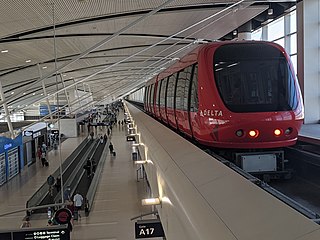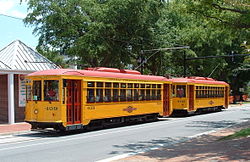The Metropolitan Transit Authority of Harris County is a major public transportation agency based in Houston, Texas, United States. It operates bus, light rail, bus rapid transit, HOV and HOT lanes, and paratransit service in the city as well as most of Harris County. It also operates bus service to two cities in Fort Bend County, and to Conroe in Montgomery County. The Metro headquarters are in the Lee P. Brown Administration Building in Downtown Houston. In 2023, the system had a ridership of 77,189,800, or about 232,800 per weekday as of the fourth quarter of 2023.

The Niagara Frontier Transportation Authority (NFTA) is the public agency responsible for operating most public transportation services in the Buffalo–Niagara Falls metropolitan area. The NFTA, as an authority, oversees a number of subsidiaries, including the NFTA Metro bus and rail system, the Buffalo-Niagara International Airport, the Niagara Falls International Airport and NFTA Small Boat Harbor. The NFTA Metro bus and rail system is a multi-modal agency, utilizing various vehicle modes, using the brand names: NFTA Metro Bus, NFTA Metro Rail, NFTA Metrolink and NFTA PAL. In 2023, the system had a ridership of 15,429,900, or about 53,600 per weekday as of the fourth quarter of 2023.

King County Metro, officially the King County Metro Transit Department and often shortened to Metro, is the public transit authority of King County, Washington, which includes the city of Seattle. It is the eighth-largest transit bus agency in the United States. In 2023, the system had a ridership of 78,121,600, or about 256,200 per weekday as of the fourth quarter of 2023. Metro employs 2,444 full-time and part-time operators and operates 1,540 buses.

Spokane Transit Authority, more commonly Spokane Transit or STA, is the public transport authority of central Spokane County, Washington, United States, serving Spokane, Washington, and its surrounding urban areas. In 2023, the system had a ridership of 9,215,700, or about 33,900 per weekday as of the fourth quarter of 2023.

The Metro Streetcar, formerly known as the River Rail Streetcar, is a two line heritage streetcar system operating in Little Rock and North Little Rock, Arkansas. It has operated since November 1, 2004. Most recently expanded in 2007, the streetcar now operates over 3.4-mile (5.5 km) of track in a figure-eight loop pattern. The Metro Streetcar is operated by Rock Region Metro. In 2023, the system had a ridership of 22,600.

Embark is the public transit agency of the COTPA trust, the largest transit agency in the state of Oklahoma. Embark has 20 interconnecting bus routes covering the city of Oklahoma City and parts of the Oklahoma City Metropolitan Area, including weekday Express service from Norman to Downtown Oklahoma City. Embark also operates paratransit, the Oklahoma City Streetcar, downtown public parking, bike share, and river ferry services. Additionally, Embark provides administrative and executive support for the Regional Transportation Authority of Central Oklahoma.
Oklahoma City is near the geographic center of the United States and is an integral point on the U.S. Interstate Network. The city is served by numerous roads and highways, toll roads, three major airports, a train station, a bus station, and a transit system.

The Capital Area Transportation Authority (CATA) is the public transit operator serving the Lansing, Michigan area, including service on the campus of Michigan State University. In 2023, the system had a ridership of 8,082,200.
The Capital Metropolitan Transportation Authority, officially stylized as CapMetro, is a public transportation provider located in Austin, Texas. It operates bus, paratransit services and a hybrid rail system known as CapMetro Rail in Austin and several suburbs in Travis and Williamson counties. In 2023, the system had a ridership of 25,229,400, or about 81,500 per weekday as of the fourth quarter of 2023.
The Southwest Ohio Regional Transit Authority (SORTA) is the public transport agency serving Cincinnati and its Ohio suburbs. SORTA operates Metro fixed-route buses, bus rapid transit, microtransit, and paratransit services. SORTA's headquarters are located at the Huntington Building in Cincinnati’s Central Business District. The agency is managed by CEO and General Manager Darryl Haley along with a 13-member board of trustees. In 2023, the system had a ridership of 13,091,500, or about 44,800 per weekday as of the fourth quarter of 2023.
The Gary Public Transportation Corporation (GPTC) is a commuter bus system in Gary, Indiana that offers service to numerous stops throughout the city and neighboring suburbs. GPTC is a public corporation owned but not directly controlled by the city.

The San Diego Metropolitan Transit System is a public transit service provider for central, southern, northeast, and southeast San Diego County, California, as well as for the city of San Diego. The agency directly operates a large transit system that includes the MTS Bus, San Diego Trolley light rail, and Rapid bus rapid transit services. The MTS also controls the San Diego and Arizona Eastern (SD&AE) freight railway and regulates taxicabs, jitneys, and other private for-hire passenger transportation services.

Streetcars or trolley(car)s were once the chief mode of public transit in hundreds of North American cities and towns. Most of the original urban streetcar systems were either dismantled in the mid-20th century or converted to other modes of operation, such as light rail. Today, only Toronto still operates a streetcar network essentially unchanged in layout and mode of operation.

The Eureka Transit Service is the city fixed-route bus system in Eureka, California. ETS operates four weekday routes between downtown Eureka, Bayshore Mall, Henderson Center, Myrtletown, Cutten, and Pine Hill. Three routes operate on Saturdays. Bus service in Eureka is provided under contract by the Humboldt Transit Authority.

Shoreline Metro is the bus system owned and operated by the city of Sheboygan, Wisconsin. Shoreline Metro services three communities with fixed route public transit system including the City of Sheboygan, Sheboygan Falls and Kohler. It operates ten fixed routes Monday through Saturday and tripper service during the school year with an additional three morning routes and four afternoon routes for school-aged children.

Little Rock is the capital and most populous city of the U.S. state of Arkansas. The city's population was 202,591 as of the 2020 census. The six-county Little Rock metropolitan area is the 81st-most populous in the United States with 748,031 residents according to the 2020 census.
The COMET, officially the Central Midlands Regional Transit Authority (CMRTA), is a regional transportation authority formed by Richland County, City of Columbia, and Lexington County on April 24, 2000, by the Central Midlands Council of Governments. The COMET consists of an intergovernmental agreement signed by Richland County, the City of Columbia, the City of Forest Acres, and Lexington County to fund, operate and maintain public transit services and mass transportation in Richland and Lexington counties in the Columbia metropolitan area of South Carolina.

Transportation in metropolitan Detroit comprises an expansive system of roadways, multiple public transit systems, a major international airport, freight railroads, and ports. Located on the Detroit River along the Great Lakes Waterway, Detroit is a significant city in international trade, with two land crossings to Canada. Three primary Interstate highways serve the region.
The OC Streetcar is a modern streetcar line currently under construction in Orange County, California, running through the cities of Santa Ana and Garden Grove. The electric-powered streetcar will be operated by the Orange County Transportation Authority (OCTA), and will serve ten stops in each direction along its 4.15-mile (6.68 km) route.
Bay Metropolitan Transportation Authority is the primary bus agency providing intra- and inter-city routes for the Bay City Metropolitan Statistical Area centered on Bay City, Michigan since 1974.















